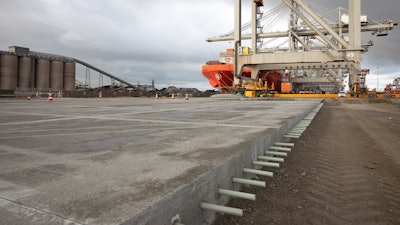Composites: The Trick to Modern, Lasting Building
Composites: The Trick to Modern, Lasting Building
Blog Article
Unlocking the Ecological Benefits of Recycled Composites in Building and Design
In the world of building and design, the utilization of recycled composites holds substantial promise for boosting sustainability practices and lowering environmental effect (composites). By including these ingenious products, there is a potential to deal with crucial problems such as waste reduction, energy conservation, and a reduction in carbon impact. The shift in the direction of a more sustainable future in these sectors depends upon unlocking the full possibility of recycled compounds. This discussion will certainly explore the diverse benefits and difficulties connected with integrating recycled composites into building and style, using a glance right into the transformative opportunities that lie ahead.

Ecological Effect Reduction
The reduction of environmental influence with the use of recycled composites in construction and layout plays a crucial duty in lasting methods. By incorporating recycled compounds right into building products, the building industry can significantly lower its carbon footprint and contribute to an extra environment-friendly future. These sustainable products, made from repurposed plastics, timber fibers, or other recycled components, provide a viable choice to standard construction products without jeopardizing on quality or durability.
Recycled compounds assist draw away waste from garbage dumps and reduce the requirement for extracting resources, thus preserving natural sources. Additionally, the production procedure of these composites often eats less power and releases fewer greenhouse gases contrasted to producing virgin products (composites). This change towards making use of recycled composites not just reduces ecological harm yet likewise advertises a circular economic situation by motivating the reuse of products that would or else be discarded
Waste Reduction
With an emphasis on reducing waste in building and construction and design, the combination of recycled compounds offers a lasting remedy to decrease ecological influence. Waste minimization is an important facet of sustainable methods, and using recycled compounds presents a chance to accomplish this goal successfully. By using materials that have currently offered their first objective, such as recycled plastics or reclaimed timber fibers, the construction and design markets can substantially decrease the quantity of waste produced and sent to land fills.
Recycled compounds have the potential to divert substantial amounts of waste from standard disposal techniques, adding to a much more round economic climate where sources are used effectively. Furthermore, the production process of recycled composites typically takes in less energy and produces fewer exhausts contrasted to virgin products, additionally minimizing the ecological footprint of construction and design projects.
Implementing waste reduction methods with the consolidation of recycled composites not only aids in preserving natural resources but additionally advertises a much more sustainable approach to structure and creating for a greener future.
Energy Conservation
Including recycled compounds not just decreases waste in construction and design but also plays an important duty in boosting power preservation methods within the market. The usage of recycled composites in building can substantially contribute to energy conservation through various means. By advertising the usage of recycled compounds in building and style, the market can make considerable strides towards achieving power performance and minimizing its carbon impact, eventually contributing to a more lasting constructed atmosphere.
Carbon Footprint Reduction
Enhancing sustainability techniques via the use of recycled composites in building and design dramatically lowers the carbon impact of the industry. By incorporating recycled products right into the production of composites, the need for virgin sources reduces, resulting in reduced power consumption and greenhouse gas exhausts related to conventional manufacturing procedures. This reduction in carbon footprint is essential in combating environment change and advertising a much more eco-friendly technique to building and design.
In addition, using recycled composites additionally assists in diverting waste from land more fills, therefore minimizing the ecological impact of disposal and advertising a circular economic situation. The carbon footprint decrease accomplished via the adoption of recycled compounds aligns with the worldwide push in the direction of sustainable techniques and the reduction of commercial emissions. It showcases a dedication to responsible source management and a change in the direction of greener alternatives in the building and construction and style fields. Eventually, by focusing on the integration of recycled compounds, the industry can make substantial strides in reducing its carbon impact and contributing to a much more lasting future.
Sustainable Future
The assimilation of recycled composites in construction and style not only addresses prompt environmental problems however additionally lays see this site a solid structure for a sustainable future in the sector. By integrating recycled compounds into structure materials and items, the construction and layout industries can dramatically decrease their dependence on virgin resources, causing a more round economic situation. This shift in the direction of sustainability is essential for minimizing the environmental influence of traditional building and construction practices, which commonly result in high degrees of waste generation and resource deficiency.

Verdict
Finally, recycled compounds supply address substantial ecological advantages in building and style by minimizing environmental impact, minimizing waste, conserving power, lowering carbon impact, and advertising a sustainable future. Embracing using recycled compounds can add to a much more environmentally-friendly method to building and design, ultimately bring about an extra sustainable and greener future for all.
The reduction of ecological influence with the use of recycled compounds in building and construction and style plays an important role in lasting techniques.With a focus on reducing waste in construction and layout, the combination of recycled composites offers a lasting service to minimize ecological impact. By advertising the usage of recycled compounds in construction and style, the industry can make considerable strides in the direction of accomplishing energy performance and minimizing its carbon footprint, inevitably contributing to an extra sustainable constructed environment.

Report this page